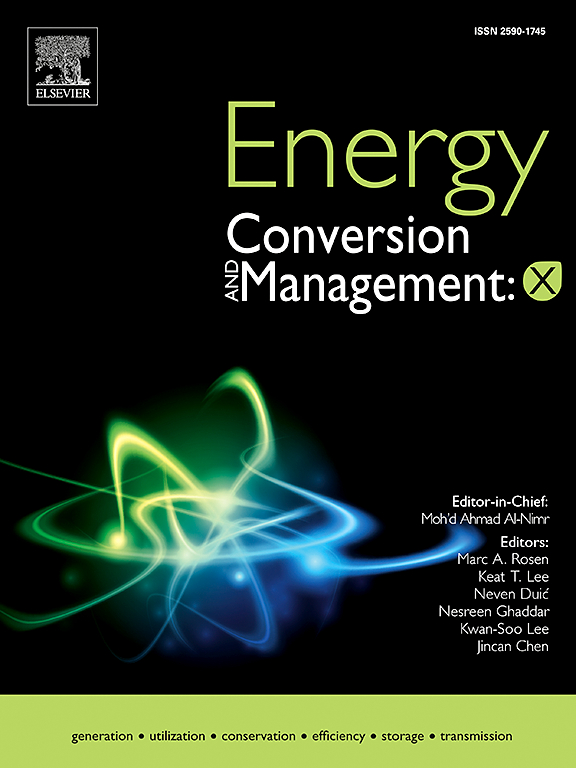吸热烃类燃料等压比热容的分布测量
IF 10.9
1区 工程技术
Q1 ENERGY & FUELS
引用次数: 0
摘要
采用吸热碳氢燃料进行主动冷却是解决高超声速飞机热管理问题的有效方法。等压比热容是设计先进热管理系统的重要参数之一。然而,由于缺乏测量分辨率,热化学反应导致燃料成分的变化以及节能计算的差异,等压比热容的准确测量面临着重大挑战。为了解决上述挑战,本工作开发了一种新的分布式流量量热计,其中量热微通道(Φ3.0 × 0.5, 1000.0 mm)通过分辨率为0.45 mm的红外热像仪划分为2200个微量元素。在轴向差分法的基础上,沿微通道确定了ehf的位置-温度-组成映射关系。以水、对二甲苯为标准材料,对等压比热容测量数据进行了可信度分析,平均绝对偏差分别为0.65%和1.28%,最大绝对偏差分别为1.32%和2.44%。分布流量热仪可在温度为298.0 ~ 1173.0 K、压力为0.1 ~ 6.0 MPa的条件下,实时测量等压比热容及其沿量热微通道的轴向分布。系统地测定了甲苯、十氢化萘和典型高密度烃燃料JP-10的等压比热容,扩展不确定度为2.85%。充分证明了分布流量热法可以成功地将热力学测量从平衡态扩展到具有显著温度梯度的稳态。本文章由计算机程序翻译,如有差异,请以英文原文为准。
Distributed measurement of isobaric specific heat capacities for endothermic hydrocarbon fuels
Active cooling with endothermic hydrocarbon fuels (EHFs) represents an effective solution to the thermal management problem of a hypersonic aircraft. The isobaric specific heat capacity for EHFs is one of important parameters for designing advanced thermal management systems. Nevertheless, the accurate measurement of the isobaric specific heat capacity presents significant challenges, due to the lack of measurement resolution, the change of fuel compositions resulting from thermochemical reactions and the discrepancy of the energy conservation calculations. To address the aforementioned challenges, this work develops a new distributed flow calorimeter, where the calorimetric microchannel (Φ3.0 × 0.5, 1000.0 mm) is divided into 2200 microelements by infrared thermography with a resolution of 0.45 mm. The mapping relationship of position-temperature-composition for EHFs can then be determined along the microchannel on the basis of the axial difference approach. The credibility analysis on measurements of isobaric specific heat capacity data is carried out by using water, p-xylene as the standard materials with the average absolute deviations of 0.65 % and 1.28 %, and the maximum absolute deviations of 1.32 % and 2.44 %, respectively. The distributed flow calorimeter can be employed for the measurements of the isobaric specific heat capacity and its axial distribution along the calorimetric microchannel in real time at temperatures from 298.0 to 1173.0 K and at pressures from 0.1 to 6.0 MPa. The isobaric specific heat capacities for toluene, decalin and JP-10, a typical high-density hydrocarbon fuel, have been systematically measured with the expanded uncertainty of 2.85 %. It is fully substantiated that the distributed flow calorimetric method can successfully extend the thermodynamic measurements from equilibrium state to steady state with significant temperature gradient.
求助全文
通过发布文献求助,成功后即可免费获取论文全文。
去求助
来源期刊

Energy Conversion and Management
工程技术-力学
CiteScore
19.00
自引率
11.50%
发文量
1304
审稿时长
17 days
期刊介绍:
The journal Energy Conversion and Management provides a forum for publishing original contributions and comprehensive technical review articles of interdisciplinary and original research on all important energy topics.
The topics considered include energy generation, utilization, conversion, storage, transmission, conservation, management and sustainability. These topics typically involve various types of energy such as mechanical, thermal, nuclear, chemical, electromagnetic, magnetic and electric. These energy types cover all known energy resources, including renewable resources (e.g., solar, bio, hydro, wind, geothermal and ocean energy), fossil fuels and nuclear resources.
 求助内容:
求助内容: 应助结果提醒方式:
应助结果提醒方式:


